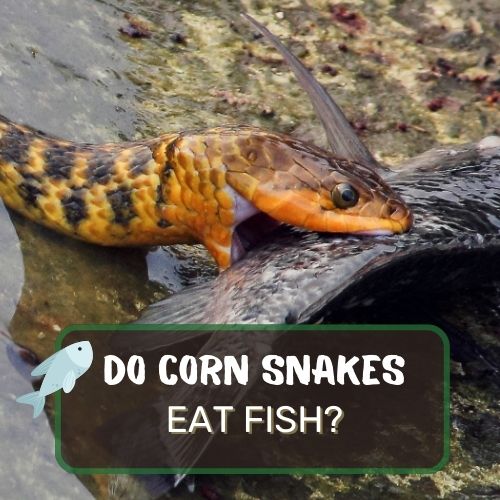
It’s a question that has intrigued many reptile enthusiasts and snake owners alike.
As the popularity of corn snakes as pets continues to rise, so does the curiosity about their dietary preferences.
In this article, we delve deep into the natural diet of corn snakes, the potential risks and benefits of introducing fish into their meals, and the importance of proper prey preparation.
By examining factors such as nutritional needs, potential health risks, and the snake’s natural behavior, we aim to provide a comprehensive answer.
If you’re looking to understand your slithery friend’s dietary needs better or are simply curious about the world of reptiles, this article promises a wealth of information.
Dive in and discover the fascinating world of corn snake nutrition!
Table of Contents
The Fishy Question: Can Corn Snakes Eat Fish? (Not Really)
Corn snakes, known for their vibrant colors and docile nature, primarily feast on rodents, birds, and their eggs in the wild. While they might be curious about fish, it’s not a natural or recommended part of their diet. Some fish contain thiaminase, an enzyme that can lead to thiamine deficiency in snakes. Additionally, fish might harbor parasites or bacteria harmful to snakes. While there have been instances where snake owners have fed fish to corn snakes, it’s safer and more nutritionally sound to stick to their natural diet, primarily consisting of rodents. So, it’s best to avoid offering fish to corn snakes.
The Potential Nutritional Benefits of Fish for Corn Snakes

Fish, as a general food source, are packed with various nutrients that can be beneficial for many animals. For corn snakes, if we were to consider fish as a potential food item, here’s what they could offer:
- Protein: Fish are a rich source of protein, essential for muscle development and overall growth. This protein can support the snake’s bodily functions and tissue repair.
- Omega-3 Fatty Acids: These essential fatty acids, especially prevalent in fatty fish like salmon, can support cell function and might contribute to a snake’s overall health.
- Vitamins: Fish contain vitamins like B12, D, and A. These vitamins play roles in nerve function, bone health, and vision, respectively.
- Minerals: Essential minerals like iodine, selenium, and zinc are abundant in fish. These minerals support metabolic processes, DNA production, and the immune system.
- Low Fat: Many fish, especially white-fleshed ones, are low in fat, making them a potentially lean source of protein.
However, it’s crucial to note that while fish offer these nutrients, they also come with risks for corn snakes, like thiaminase content and potential parasites.
The natural diet of corn snakes, primarily rodents, already provides them with the nutrients they need. So, while fish have nutritional benefits, they aren’t necessarily suited or recommended for corn snakes.
The Natural Diet of Corn Snakes

Like any pet, understanding their dietary needs is crucial for their health and longevity. So, let’s dive deep into the world of corn snakes and their culinary preferences.
Corn snakes in the wild: What do they eat?
In the wild, these snakes aren’t pondering the nutritional benefits of salmon or tilapia. Instead, they’re on the hunt for a very different kind of meal.
Corn snakes primarily feast on small mammals. Think mice, young rats, or even baby birds. These creatures are abundant in the snake’s natural habitat, making them the perfect prey.
The snake’s body has evolved over millennia to derive the maximum nutritional benefit from these animals. The protein from these small mammals supports their growth, muscle development, and tissue repair.
But it’s not just about the mammals. Corn snakes also have a penchant for birds and their eggs. These provide a different set of nutrients, ensuring a well-rounded diet.
For instance, bird eggs are a rich source of essential fats and proteins, which are vital for the snake’s health.
Importance of small mammals, birds, and their eggs in their diet.
Now, you might be thinking, “Why not mix things up a bit? Why stick to just rodents and birds?” Well, there’s a science to it. The corn snake’s digestive system is specifically adapted to process the nutrients found in these animals.
For example, the calcium from the bones of small mammals is crucial for the snake’s skeletal health.
The fats from the bird eggs provide the energy needed for the snake’s daily activities. And the various vitamins and minerals found in these prey items support everything from the snake’s nerve function to its immune system.
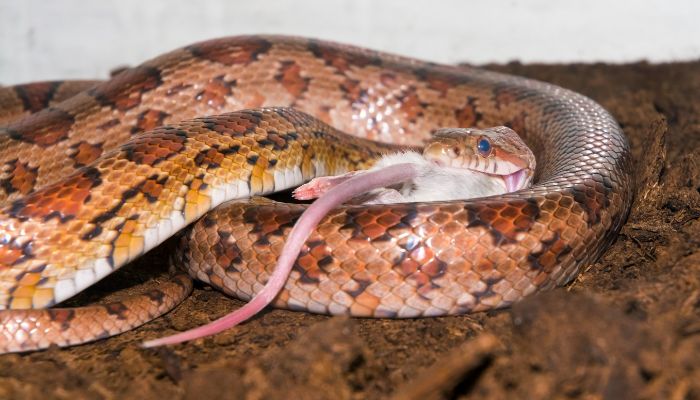
The risks of deviating from their natural diet.
Let’s circle back to our original question: “Can corn snakes eat fish?” While fish are nutritionally dense, offering proteins, Omega-3 fatty acids, and various vitamins, they’re not a natural part of the corn snake’s diet.
Introducing fish into their diet can be akin to suddenly asking a vegetarian to start eating meat.
Their system isn’t prepared for it.
Fish can contain thiaminase, which can lead to thiamine deficiency in snakes. This deficiency can have severe neurological implications.
Moreover, fish might harbor parasites or bacteria harmful to snakes. And while some snake owners might argue they’ve successfully fed their corn snakes fish, it’s a gamble. Why risk the health of your beloved pet for an experiment?
In conclusion, while it’s tempting to think outside the box and offer varied foods to our pets, it’s essential to prioritize their health and well-being.
For corn snakes, this means sticking to what nature intended: a diet rich in small mammals, birds, and their eggs.
The Risks of Feeding Fish to Corn Snakes
When it comes to our pets, especially exotic ones like corn snakes, it’s tempting to experiment with their diet. After all, variety is the spice of life, right?
But before you consider dropping that goldfish into your snake’s vivarium, let’s delve into the potential risks.
Thiaminase in fish and the danger of thiamine deficiency.
Fish, especially certain species, contain an enzyme called thiaminase. Now, while this might sound like some fancy nutrient, it’s quite the opposite for our slithery friends.
Thiaminase breaks down thiamine, a vital vitamin for snakes. A deficiency in thiamine can lead to neurological issues, loss of appetite, and in severe cases, even death.
So, while that fish might seem like a nutritious treat, it could be setting up your corn snake for some serious health problems.
Potential parasites or bacteria in fish.
Fish swim in water, and water can be a breeding ground for all sorts of nasties. From parasites to harmful bacteria, there’s a lot that can hitch a ride inside a fish.
When a corn snake consumes an infected fish, these parasites and bacteria can transfer to the snake, leading to digestive issues, infections, and other health complications. It’s a risk that’s simply not worth taking.
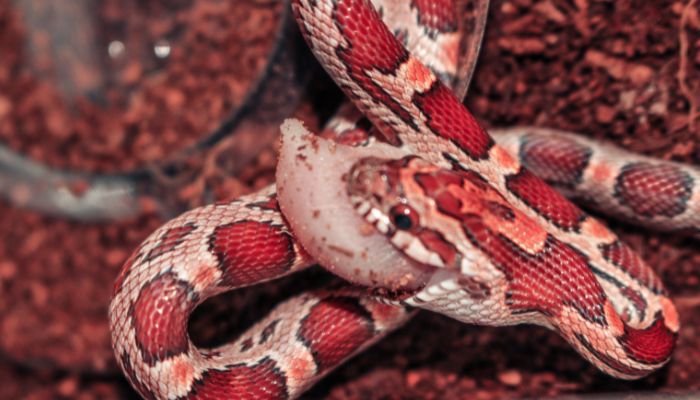
The importance of sourcing fish from reputable suppliers.
If you’re still considering the occasional fish treat for your corn snake (despite the risks), it’s paramount to source the fish from reputable suppliers.
These suppliers ensure the fish are raised in clean environments, are free from harmful chemicals, and have a lower risk of carrying parasites. But remember, even the cleanest fish can still contain thiaminase.
Proper preparation before feeding.
Should you decide to tread this risky path, proper preparation is crucial. This means thoroughly cleaning the fish, ensuring it’s free from any external contaminants, and if you’re using frozen fish, thawing it correctly.
Never feed raw fish directly from a packet; always rinse it under clean water.
The Importance of Variety in Diet
Corn snakes, like all creatures, thrive on a varied diet. But variety doesn’t mean introducing foods that are unnatural or potentially harmful.
Why a varied diet is crucial for corn snakes.
A varied diet ensures that corn snakes receive all the essential nutrients they need. It prevents nutritional deficiencies and ensures that the snake remains active, healthy, and has a robust immune system.
Plus, introducing different foods can also provide mental stimulation for the snake, keeping it engaged and curious.
Different nutritional profiles of various prey items.
Each prey item offers a unique set of nutrients. For instance, mice might be rich in certain proteins and fats, while birds might offer different vitamins. By providing a mix, you ensure that the snake gets a well-rounded meal.
The role of rodents in their diet.
Rodents are the cornerstone of a corn snake’s diet. They offer the perfect balance of nutrients, are easy to digest, and are readily available. Mice and rats provide the bulk of the protein, fats, and other essential nutrients that corn snakes need to thrive.
Occasional treats: chicks or quail.
While rodents should form the majority of the diet, occasional treats like chicks or quail can be introduced. These not only provide variety but also introduce different nutrients into the snake’s diet.
However, they should be given sparingly and always sourced from reputable suppliers.
While it’s essential to provide variety in a corn snake’s diet, it’s equally crucial to ensure that this variety is safe, nutritious, and beneficial for the snake.
Stick to their natural diet, and your corn snake will thank you with good health and longevity.
Proper Prey Preparation and Size
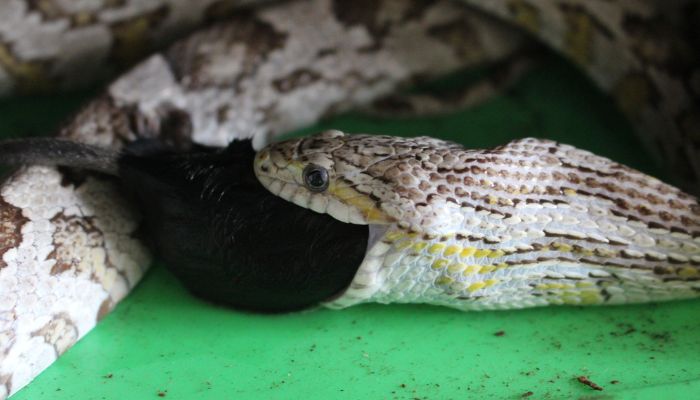
Feeding your corn snake isn’t as simple as just tossing in a mouse and calling it a day. There’s an art and science to it, ensuring your snake gets the most out of its meal without any health risks.
Ensuring prey is of appropriate size.
One of the golden rules of feeding snakes is ensuring the prey’s size is appropriate. A good rule of thumb is that the prey should not be wider than the snake’s widest part.
Offering prey that’s too large can lead to choking, regurgitation, or even internal injuries. On the flip side, consistently feeding prey that’s too small might not provide adequate nutrition.
The importance of defrosting and warming prey before feeding.
If you’re using frozen prey, it’s crucial to thaw it properly. This means allowing it to come to room temperature naturally, avoiding methods like microwaving.
Once thawed, it’s a good practice to warm the prey slightly, mimicking the body temperature of live prey. This can make it more appealing to the snake and aid in digestion.
Potential risks of not preparing prey properly.
Improper preparation can lead to a host of issues. Feeding frozen prey can cause digestive problems. Prey that’s too large can lead to choking.
And not cleaning or sourcing prey from reputable suppliers can introduce parasites or diseases. Always prioritize your snake’s health in your feeding practices.
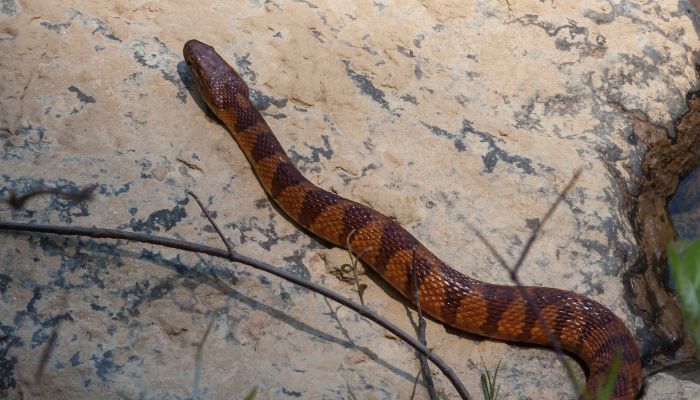
Conclusion
You’ve journeyed through the intricate world of corn snake nutrition, unraveling the age-old question: “Can corn snakes eat fish?”
By now, you understand the natural diet of these captivating reptiles and the potential risks associated with introducing fish into their meals.
It’s clear that while fish offer certain nutritional benefits, they might not be the best choice for our slithery friends due to potential health concerns. The importance of proper prey preparation and size cannot be overstated, ensuring the well-being of your pet.
Remember, as a responsible reptile enthusiast, your primary goal is to provide the best care for your corn snake. Sticking to their natural diet and understanding their needs will ensure they thrive and live a healthy life.
Your curiosity and dedication to learning are commendable. Keep up the good work, and always prioritize the well-being of your pets. With the knowledge you’ve gained, you’re well on your way to becoming an exemplary corn snake caretaker.
Keep seeking, keep learning, and always strive for the best in everything you do!
FAQ
What can I feed my corn snake?
Corn snakes thrive on a diet of small mammals like mice and rats. They can also eat birds and their eggs. It’s best to stick to this natural diet for optimal health.
Can snakes eat cooked fish?
While snakes can physically consume cooked fish, it’s not recommended. Cooking alters the nutritional profile, and it’s still not a natural food item for corn snakes. Plus, cooked fish can lack certain essential nutrients present in their regular diet.
Can corn snakes eat crickets?
While corn snakes can eat crickets, they shouldn’t form a significant part of their diet. Crickets can be an occasional treat but don’t provide the full range of nutrients that rodents do.
Can snakes eat pieces of meat?
Snakes can consume pieces of meat, but it’s not ideal. Whole prey provides a balanced diet, including bones for calcium and organs for other essential nutrients. Pieces of meat lack this balance and can lead to nutritional deficiencies.

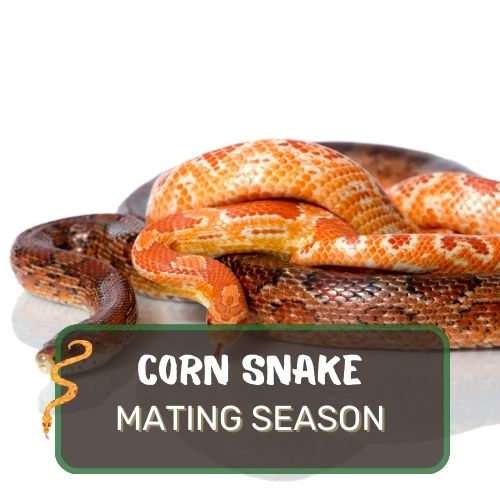
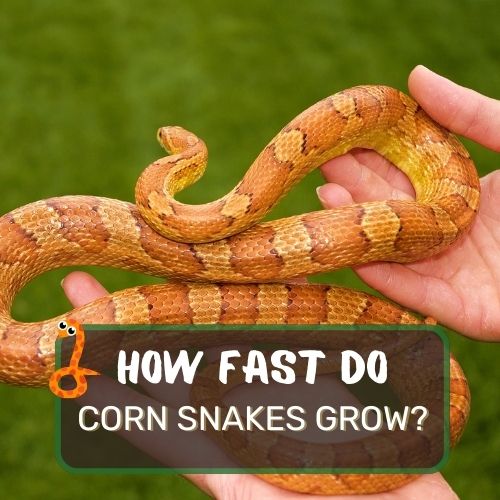
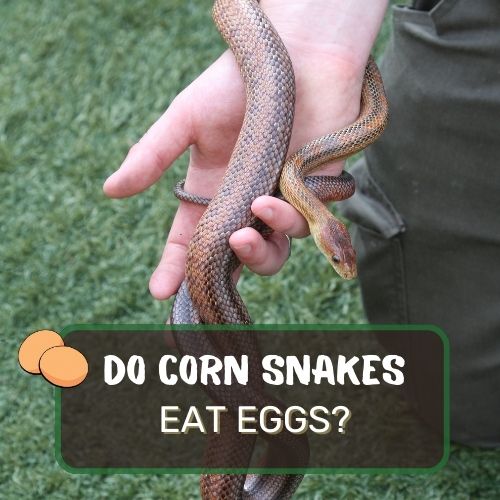
0 Comments